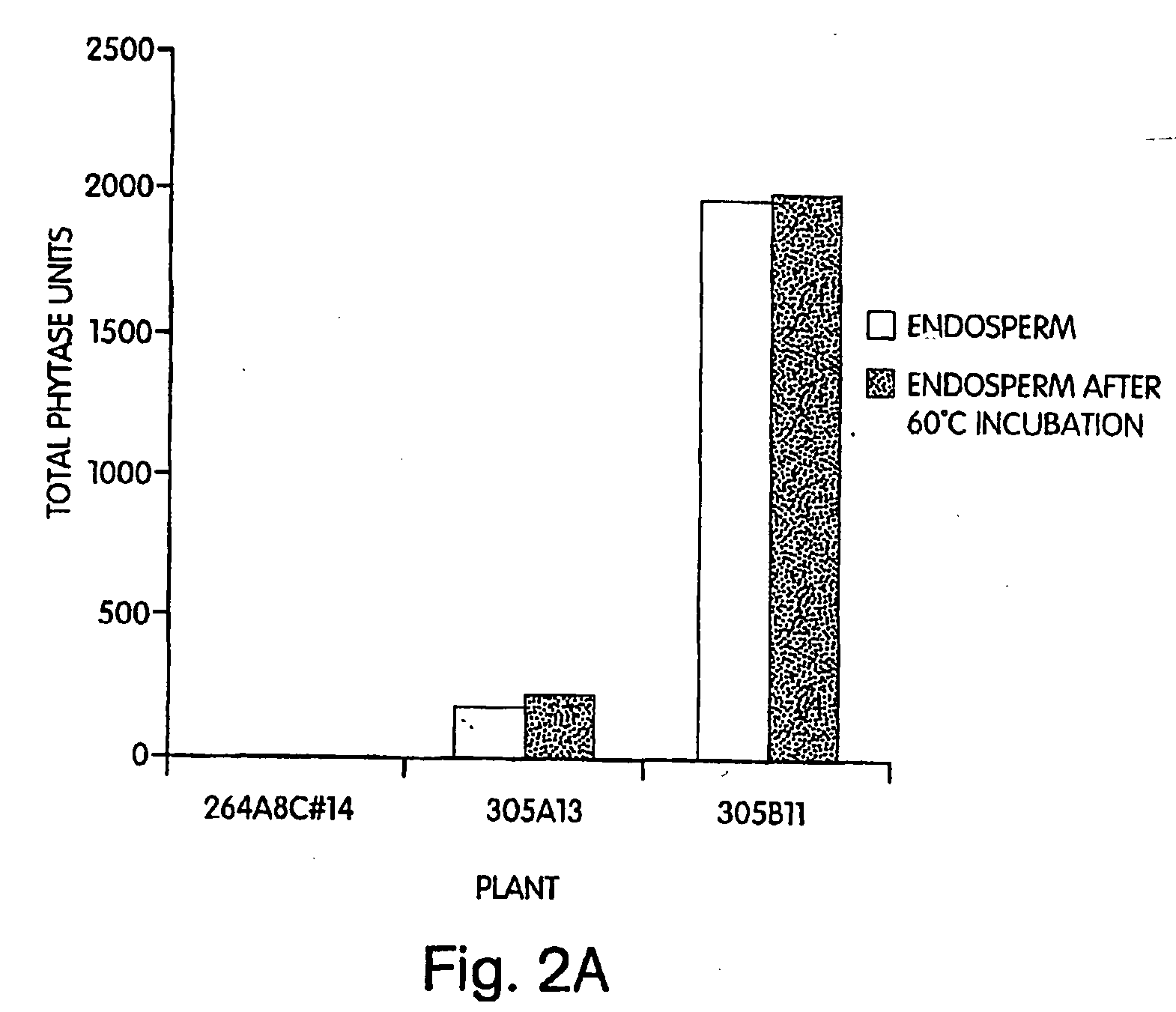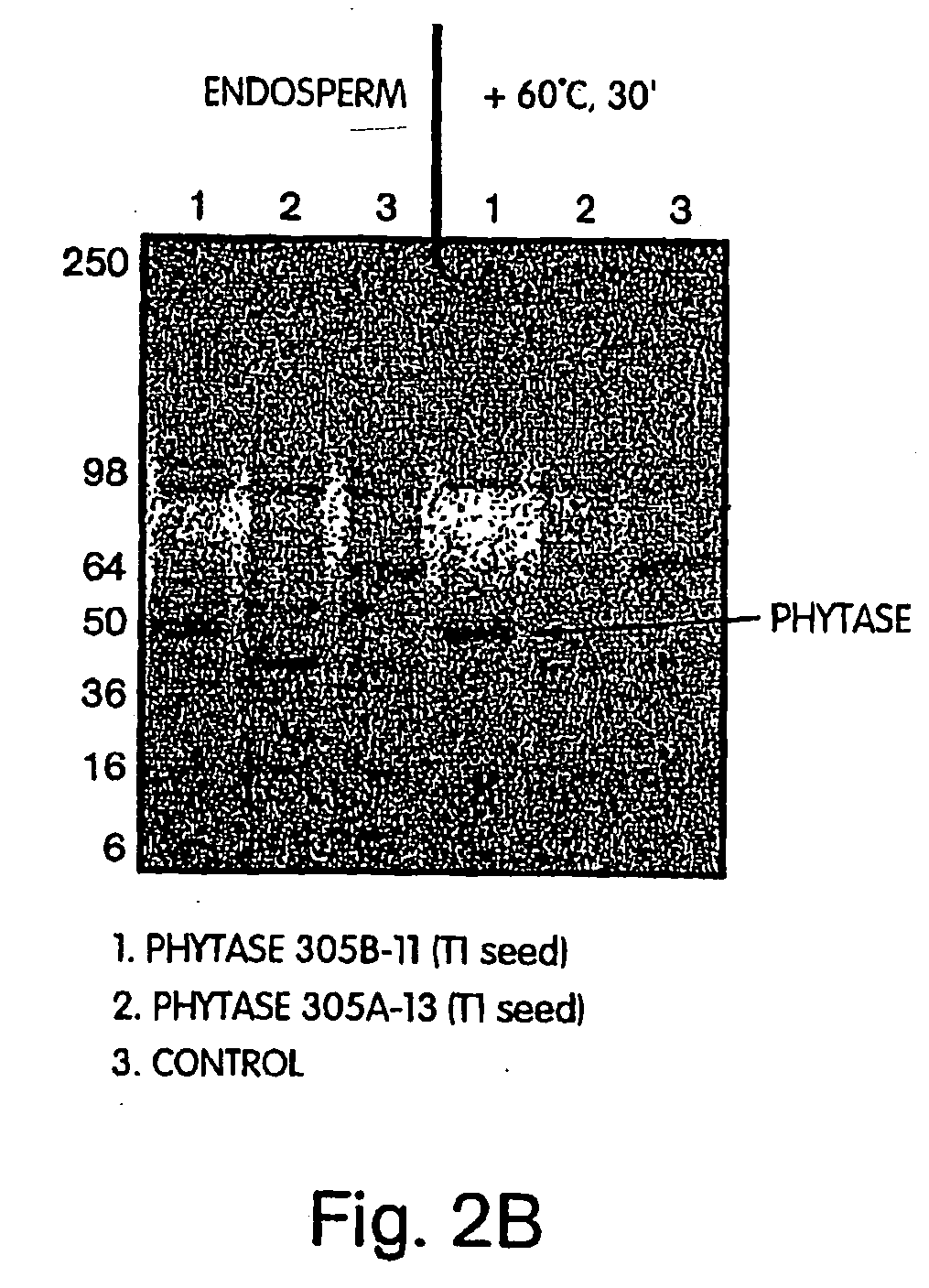Thermotolerant phytase for animal feed
a phytase and thermotolerant technology, applied in the field of molecular biology, can solve the problems of poor digestibility/availability of phosphorus in this form, many currently used phytases lose activity, and many currently used phytases are not adequate in diets, so as to improve the conversion ratio of feed or animal weight, reduce/decreep the feed conversion ratio or the effect of weight gain
- Summary
- Abstract
- Description
- Claims
- Application Information
AI Technical Summary
Benefits of technology
Problems solved by technology
Method used
Image
Examples
example 1
[0316] The deduced amino acid sequence of Nov9x (SEQ ID NO: 1) was converted into a maize optimized nucleic acid sequence using the Wisconsin GCG analysis program Backtranslate and the codon table for highly expressed maize genes (see, e.g., U.S. Pat. No. 5,625,136). The synthetic gene was prepared by Integrated DNA technologies, Inc. (Coralville, Iowa).
[0317] Nov9X phytase amino acid sequence (the 8 mutations are bolded and underlined) (SEQ ID NO:1)
MAQSEPELKLESVVIVSRHGVRAPTKATQLMQDVTPDAWPTWPVKLGELTPRGGELIAYLGHYWRQRLVADGLLPKCGCPQSGQVAIIADVDERTRKTGEAFAAGLAPDCAITVHTQADTSSPDPLFNPLKTGVCQLDNANVTDAILERAGGSIADFTGHYQTAFRELERVLNFPQSNLCLKREKQDESCSLTQALPSELKVSADCVSLTGAVSLASMLTEIFLLQQAQGMPEPGWGRITDSHQWNTLLSLHNAQFDLLQRTPEVARSRATPLLDLIKTALTPHPPQKQAYGVTLPTSVLFIAGHDTNLANLGGALELNWTLPGQPDNTPPGGELVFERWRRLSDNSQWIQVSLVFQTLQQMRDKTPLSLNTPPGEVKLTLAGCEERNAQGMCSLAGFTQIVNEARIPACSL
[0318] Nov9X phytase maize-optimized nucleic acid sequence (SEQ ID NO:2) BamHI and SacI cloning sites (underlined) were included...
example 2
Genetic Modification of Maize and Wheat
[0338] The synthetic Nov9X gene inserted into an appropriate vector as described above was introduced into maize by Agrobacterium-mediated transformation and into wheat by biolistic transformation. Stable transformants were regenerated from tissue cultured on selective media using the Positech system in accordance with U.S. Pat. Nos. 5,767,378 and 5,994,629.
[0339]Agrobacterium-Mediated Transformation of Maize
[0340] Transformation of immature maize embryos is performed essentially as described in Negrotto et al., (2000) Plant Cell Reports 19: 798-803. Various media constituents described therein can be substituted.
[0341] Transformation Plasmids and Selectable Marker
[0342] The genes used for transformation are cloned into a vector suitable for maize transformation as described above. Vectors used contain the phosphomannose isomerase (PMI) gene (Negrotto et al. (2000) Plant Cell Reports 19: 798-803) as a selectable marker.
[0343] Preparation...
example 3
Accumulation of Nov9X Phytase in Maize Seed from First Generation Transgenic Plants Transformed with Vectors pNOV4057 and pNOV4061.
[0360] An exemplary formulation of phytase enzyme produced in corn seed is in the form of a liquid extract. Here, the enrichment of Nov9X phytase by degermination, water extraction, heating, and centrifugation is described.
[0361] Fresh kernels from two of the first generation transgenic plants to produce mature ears were analyzed for phytase activity. The plants were derived from embryos that had been transformed with plasmids pNOV4057 (event 305A13) and pNOV4061 (event 305B11). Fresh kernels of the same age were obtained from a third ear that did not contain the Nov9X phytase gene. This control plant (event 264A8C#14) contained the vector pNOV4314, which encodes a heterologous enzyme. Six kernels and six endosperm from each of the three ears were pooled and crushed using a mortar and pestle. A total of 10 ml ddH2O was added to the kernels. The solubl...
PUM
| Property | Measurement | Unit |
|---|---|---|
| pH | aaaaa | aaaaa |
| pH | aaaaa | aaaaa |
| pH | aaaaa | aaaaa |
Abstract
Description
Claims
Application Information
 Login to View More
Login to View More - R&D
- Intellectual Property
- Life Sciences
- Materials
- Tech Scout
- Unparalleled Data Quality
- Higher Quality Content
- 60% Fewer Hallucinations
Browse by: Latest US Patents, China's latest patents, Technical Efficacy Thesaurus, Application Domain, Technology Topic, Popular Technical Reports.
© 2025 PatSnap. All rights reserved.Legal|Privacy policy|Modern Slavery Act Transparency Statement|Sitemap|About US| Contact US: help@patsnap.com



